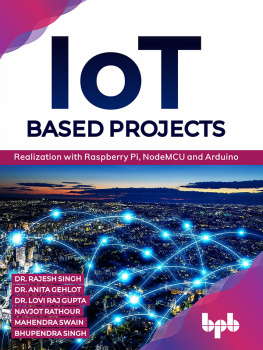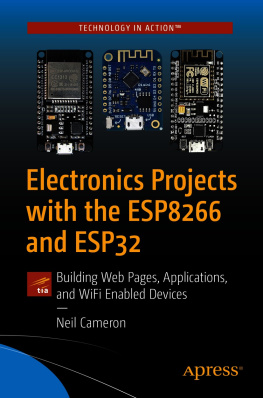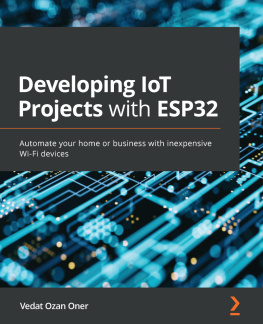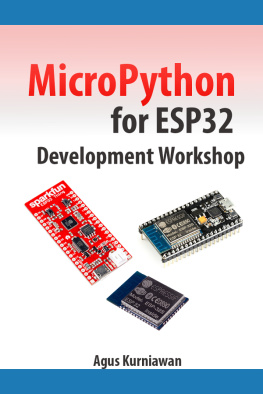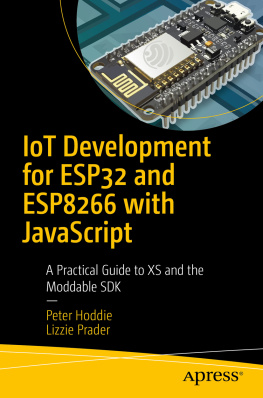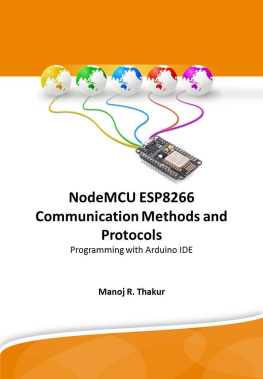HANDBOOK OF NODEMCU ESP32
Top 100 Internet of Things (IoT) Project Ideas with NodeMCU, ESP8266, and ESP32 for Beginners and Inventors
(New Edition 2023)

ARSATH NATHEEM S
Copyright 2023 by ARSATH NATHEEM S
All rights Reserved. 2023 Edition
Imprint: Independently published
Author: Arsath Natheem S
This NodeMCU and ESP32 project handbook is geared towards providing exact and reliable data with respect to the subject and issue covered. The publication is sold with the idea that the publisher doesn't have to make any qualified services or do anything else.
No way is it okay to copy, print, or share any part of this book, either in digital e-book (eBook) format or on paper. It is against the law to re-document this textbook, and you can't keep this manuscript unless the publisher gives you written permission to do so. All rights reserved.
The respective authors own all rights not held by the publisher. The attributes that are used are without any consent, and the book of the trademark is without permission or backing by the brand owner. All trademarks and brands within this book are for descriptive purposes only and are the owned by the owners themselves, not associated with this textbook
WHY I WROTE THIS BOOK
When most of us think of the word "education," the first thing that comes to mind is the kind of formal learning that takes place in elementary, middle, and high schools as well as in colleges. Even though this is not the only way to learn, tacit and practical knowledge is often something we can't learn from books. It comes from solving problems in the real world and practicing, and it has to do with experience, intuition, ideals, creative thinking, emotions, values, skills, and attitudes. Project-based learning creates the next generation of STEAM programs and tacit knowledge that give students the power to learn creatively in middle school, high school, and college and help them do well.
Learning through collaborative projects will have a more lasting effect on the student's education in the long run. It also makes the part about understanding more fun, since students can understand more when they learn in a group. Thus, let's focus on many easy NodeMCU, ESP8266, and ESP32 projects to boost student creativity. Because the electronic project is always working and improves the current system, it might help students develop a practical, forward-looking mindset.
Tell me and I forget, teach me and I may remember, involve me and I learn Benjamin Franklin
WHY YOU SHOULD READ THIS BOOK
"HANDBOOK OF NODEMCU ESP32 " is a comprehensive guide for beginners looking to get started with the NodeMCU and ESP32 microcontrollers. The book contains 100 practical projects that cover a wide range of topics, including Internet of Things (IoT), home automation, robotics, and more. The book begins with an introduction to the NodeMCU and esp32, covering their features, capabilities, and how to set them up for development. It then walks the reader through the process of creating their first project, including how to write and upload code, and how to troubleshoot any issues that may arise. From there, the book delves into a variety of projects that showcase the power and versatility of the NodeMCU and esp32. These projects range from simple projects like controlling an LED with a button, to more complex projects like building a home automation system or a remote-controlled robot. Throughout the book, the reader will learn how to use a variety of sensors and actuators, including temperature and humidity sensors, motion detectors, and servo motors, to create interactive and responsive projects. The book also covers advanced topics such as networking, data storage, and communication protocols, helping the reader to create projects that can interact with the internet and other devices.
This book is organized into four chapters, beginning with the fundamentals of NodeMCU, ESP8266, and ESP32 and moving on to getting started with programming esp8266 and ESP32 and installing NodeMCU and ESP32 in the Arduino IDE. The third part will go through how to get started with ThingSpeak. There are 100 fascinating project ideas for esp8266 NodeMCU and esp32 in the fourth chapter. It also explains the basics of how open-source electronics work. This means that college students, schoolchildren, and hobbyists can use practical schematic diagrams to learn about electronics at all levels, from beginner to expert. I hope that students and teachers will find this project book useful for mini-projects and as a great project guide for science fair projects and other new ideas.
In summary, " HANDBOOK OF NODEMCU ESP32" is a valuable resource for anyone looking to learn about and get started with the NodeMCU and esp32 microcontrollers. It provides a hands-on approach to learning, with step-by-step instructions and examples that help the reader to create a wide range of projects and learn the skills needed to become a confident maker.
Dear Aspiring Electronic Lovers!
Congratulations! By choosing this book, you've taken a very significant step toward starting and making your own projects. It is our pleasure to thank you for your purchase and wish you success in your upcoming projects. In addition, these project ideas are not ranked in any particular order. The ideas are yours to choose based on what you feel comfortable with and are passionate about. In addition, it's important to figure out how to execute each of these ideas, since an idea is just the beginning. It is our sincere hope that you will find this book to be an invaluable resource both now and in the future. Its the beginning of a long journey to success.
Hopefully, this book will help you create your story.
Best wishes!
TABLE OF CONTENTS
CHAPTER 1
BASICS OF NODEMCU, ESP32
Introduction
NodeMCU is an open-source IoT (Internet of Things) platform that includes firmware which runs on the ESP8266 Wi-Fi SoC from Espressif Systems and hardware which is based on the ESP-12 module. It was created in 2014 by a team of developers who wanted to provide a low-cost and flexible platform for IoT projects. The ESP32 is a low-cost microchip with Wi-Fi and Bluetooth capabilities, developed by Espressif Systems , a Chinese manufacturer of microcontrollers and integrated circuits. It was released in 2016 as a successor to the ESP8266, and it has since become a popular choice for IoT projects due to its improved performance and additional Bluetooth connectivity.

Espressif Systems was founded in 2008 by a team of Chinese engineers who were interested in developing low-cost, high-performance microcontrollers for the emerging IoT market. In addition to the ESP8266 and ESP32, the company has also released a range of other microchips and modules for IoT applications.
Which is better, the NodeMCU ESP8266 or the ESP32?
The ESP8266 and the ESP32 are both low-cost microchips with Wi-Fi and microcontroller capabilities, making them well-suited for Internet of Things (IoT) applications. Both chips have their own strengths and may be better suited for certain projects depending on your needs.
Here are some key differences between the ESP8266 and the ESP32:

- Performance: The ESP32 has a more powerful processor and more RAM than the ESP8266, making it better suited for applications that require more processing power and memory.


